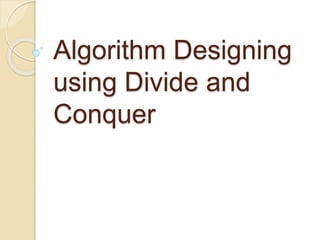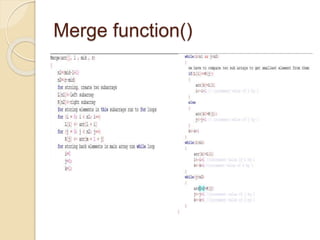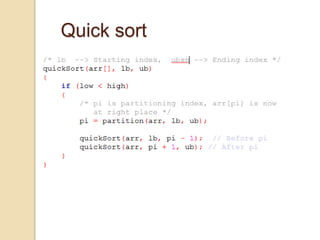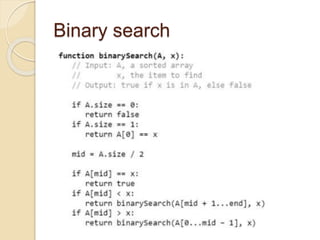Algorithm designing using divide and conquer algorithms
- 1. Algorithm Designing using Divide and Conquer
- 2. Divide and Conquer Algorithms Top-down technique for designing algorithms. Divides the problem into smaller sub problems and then composes the partial solutions into the solutions of the original problem
- 3. Basic problem-solving approach The Working: 1- Divide 2- Conquer 3- Combine
- 4. Divide and Conquer Algorithms based on Divide and Conquer: Merge Sort Quick Sort Binary Search Tower of Hanoi
- 5. Merge sort IDEA: Break down a list into several sub-lists until each sub list consists of a single element and merge those sub lists in a manner that results into a sorted list.
- 7. Merge sort
- 8. Quick sort Doesn’t use additional storage Selects a pivot value to assist with splitting the array The actual position where the pivot value belongs in the final sorted array, commonly called as split point , will be used to divide the array for subsequent calls to the quick sort .
- 9. Quick Sort Different versions: Always pick first element as pivot. Always pick last element as pivot. Pick a random element as pivot. Pick median as pivot.
- 10. Quick sort Step 1 - Choose the first index value has pivot. Step 2 − Take two variables to point left and right of the array. Step 3 − left points to the low index. Step 4 − right points to the high index. Step 5 − while value at left is less than pivot move right Step 6 − while value at right is greater than pivot move left Step 7 − if both step 5 and step 6 does not match swap left and right Step 8 − if left ≥ right, the point where they met is new pivot
- 11. Partition fun()
- 12. Quick sort
- 13. Binary Search Works on sorted array. Uses the middle array to compare. 2 3 6 8 10 12 15 MIDDLE 1. Check if the Middle number is equal to our number True Terminate False Continue 2. Check if our number is less than the middle no True 2 3 6 MIDDLE Continue from Step 1 with this array
- 14. False Continue 3. Check if our number is greater than the middle no True 10 12 15 MIDDLE False “Element not there in the array ” Continue from Step 1 with this array
- 15. Binary search
- 16. Tower of Hanoi A mathematical puzzle where we have three rods and n disks. Objective: To move the entire stack to another rod Rules: 1) Only one disk can be moved at a time. 2) a disk can only be moved if it is the uppermost disk on a stack. 3) No disk may be placed on top of a smaller disk.
- 17. Tower of Hanoi
- 18. Advantages Optimal for a general case solution, like merge sort. Parallel processing. Memory Access
- 19. Disadvantages Problem decomposition Recursive nature Lead to Huge recursive stacks
Editor's Notes
- #19: 1.In a perfect world, where the problem is easy to divide, and the sub-problem at some level is easy to solve, divide and conquer can be optimal for a general case solution, like merge sort. 2. Parallel availability, divide and conquer by it’s very nature lends itself well to parallel processing. 3. Memory Access: Each problem is divided into various sub-problems. Thus, the size of each sub-problem becomes extremely small and can be stored and processed in the cache memory. It requires 0 or extremely small need of using main memory.
- #20: 1.Problem decomposition may be very complex and thus not really suitable to divide and conquer. 2.Recursive nature of the solution may end up duplicating sub-problems, dynamic/memoized solutions may be better in some of these cases, like Fibonacci. 3. Recursion into small/tiny base cases may lead to huge recursive stacks, and efficiency can be lost by not applying solutions earlier for larger base cases.


















